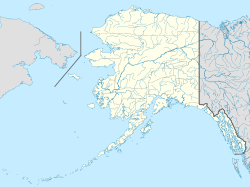Cape Pole, Alaska facts for kids
Quick facts for kids
Cape Pole
|
|
|---|---|
|
Populated Place
|
|
| Country | United States |
| State | Alaska |
| Borough | Prince of Wales-Hyder |
| Elevation | 7 ft (2 m) |
| Population
(2010)
|
|
| • Total | 0 |
| Time zone | UTC-9 (Alaska (AKST)) |
| • Summer (DST) | UTC-8 (AKDT) |
| Area code | 907 |
| GNIS feature ID | 1420870 |
Cape Pole was once a busy place on Kosciusko Island in Alaska. It was known as a logging camp, a place where people lived and worked cutting down trees. From 1954, it was a thriving community. However, a court decision in 1978 led to its closure.
A post office opened in Cape Pole in 1949 but closed just a few years later in 1953. Today, some old buildings still stand there. But no one has officially lived in Cape Pole since 1980.
Contents
A Look Back: Cape Pole's Story
Cape Pole has an interesting past, especially during and after World War II.
Early Days and World War II
- 1944: A Coast Guard ship, the McLane, delivered mail to Cape Pole. This happened while it was on patrol.
- World War II: During the war, logging started on Kosciusko Island. This was because large Sitka Spruce trees were needed. They were used to build airplanes.
- 1948: A Coast Guard rescue plane had to land there. It was on a mercy flight from Ketchikan.
- 1949: The Cape Pole post office was officially opened. It helped people send and receive mail.
- 1953: The post office closed down.
The Logging Camp Era
- 1954: The L.O.G. Logging company started the Cape Pole logging camp. The company was owned by Lawrenson, Olson, and Gibbons. Ole Olson managed the logging work. Cape Pole was one of many logging camps in the Tongass National Forest.
- 1962: Cape Pole was a busy logging town. About 100 people lived there. There were camps in both Edna Bay and Cape Pole. Tree cutters often stayed in Edna Bay. The main logging work happened in Cape Pole.
- 1965-1966: L.O.G. Logging was sold to Alaska Lumber & Pulp. New managers took over the camp.
- 1975-1976: Telephone and television services finally arrived in Cape Pole. This helped connect the town to the outside world.
Life in an Isolated Community
Cape Pole was a very isolated place in Southeast Alaska.
- Travel: Most people traveled by seaplane. They flew mainly from Ketchikan.
- Supplies: A cargo boat called the Island Trader brought heavy items. It also brought vehicles from Ketchikan. People often called it the "Mail Boat."
- Communication: For a long time, people only communicated by mail or radio. Then, around 1975, the State of Alaska installed a satellite dish. This brought limited TV and phone service.
- Healthcare: Lawrenson's wife, Stella, was a nurse. She helped with injuries that didn't need a doctor. Going to a doctor in town was a huge trip back then.
Cape Pole School
The school in Cape Pole was important for the children living there.
- It started as a single-room schoolhouse.
- At its busiest, it had two rooms. About 30 students attended the school.
- Later, it went back to being a one-room school.
- Audrey Gumm was the first school teacher. She was the wife of Phil Gumm, who worked for the Forest Service.
Who Lived in Cape Pole?
| Historical population | |||
|---|---|---|---|
| Census | Pop. | %± | |
| 1960 | 92 | — | |
| 1970 | 123 | 33.7% | |
| 1980 | 29 | −76.4% | |
| U.S. Decennial Census | |||
Cape Pole first appeared on the U.S. Census in 1960. It was listed as a small, unincorporated village.
- In 1980, it was named a "census-designated place." This means it was a specific area counted by the census.
- However, logging stopped, and most people left.
- So, in 1990, Cape Pole was removed from the census. It has not been counted separately since.
Notable Residents
- Verdie Bowen: He later became a councilman in Wasilla in 2004.
Where is Cape Pole?
Cape Pole is located at 55°57′54″N 133°47′36″W / 55.96500°N 133.79333°W. It sits on the eastern shore of Fishermans Harbor. This is on the southwest coast of Kosciusko Island in Alaska.


